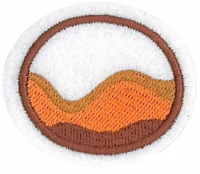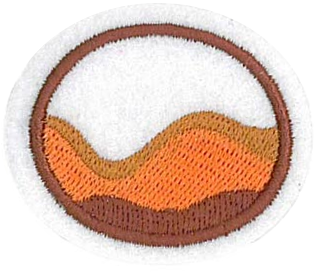Difference between revisions of "AY Honors/Dunes/Requirements"
Jomegat bot (talk | contribs) m (Jomegat bot moved page AY Honor Dunes Requirements to AY Honor Dunes Requirements: Bot: Moved page) |
m (- Category of Honor Requirements) |
||
| (8 intermediate revisions by 3 users not shown) | |||
| Line 1: | Line 1: | ||
| − | + | {{HonorSubpage}} | |
| − | |||
| − | |||
| − | + | <section begin=Body /> | |
| − | |||
| − | <b> | + | <b>1. <section begin=req1 /><noinclude><translate><!--T:1--> |
| − | < | + | </noinclude>What are dunes? What is the primary ingredient? |
| + | <noinclude></translate></noinclude><section end=req1 /></b> | ||
| − | <b> | + | <b>2. <section begin=req2 /><noinclude><translate><!--T:2--> |
| − | <section end= | + | </noinclude>Name 4 items needed for dune formation. |
| + | <noinclude></translate></noinclude><section end=req2 /></b> | ||
| − | + | <b>3. <section begin=req3 /><noinclude><translate><!--T:3--> | |
| − | < | + | </noinclude>Explain the following three ways that wind moves sand. |
| + | <noinclude></translate></noinclude><section end=req3 /></b> | ||
| − | :<b> | + | :<b>a. <section begin=req3a /><noinclude><translate><!--T:4--> |
| − | < | + | </noinclude>Surface Creep |
| + | <noinclude></translate></noinclude><section end=req3a /></b> | ||
| − | :<b> | + | :<b>b. <section begin=req3b /><noinclude><translate><!--T:5--> |
| − | < | + | </noinclude>Saltation |
| + | <noinclude></translate></noinclude><section end=req3b /></b> | ||
| − | <b> | + | :<b>c. <section begin=req3c /><noinclude><translate><!--T:6--> |
| − | < | + | </noinclude>Suspension. |
| + | <noinclude></translate></noinclude><section end=req3c /></b> | ||
| − | <b> | + | <b>4. <section begin=req4 /><noinclude><translate><!--T:7--> |
| − | <section end= | + | </noinclude>Explain the following dune formations: barchans, star dunes, linear or longitudinal dunes, parabolic, dome |
| + | <noinclude></translate></noinclude><section end=req4 /></b> | ||
| − | <b> | + | <b>5. <section begin=req5 /><noinclude><translate><!--T:8--> |
| − | <section end= | + | </noinclude>What is Ecological Succession? How is this demonstrated in dune communities? |
| + | <noinclude></translate></noinclude><section end=req5 /></b> | ||
| − | <b> | + | <b>6. <section begin=req6 /><noinclude><translate><!--T:9--> |
| − | <section end= | + | </noinclude>What is dune blowout? How does it relate to succession? |
| + | <noinclude></translate></noinclude><section end=req6 /></b> | ||
| − | <b> | + | <b>7. <section begin=req7 /><noinclude><translate><!--T:10--> |
| − | <section end= | + | </noinclude>What are pioneer plants? What is their purpose in dune communities? Give two examples. |
| + | <noinclude></translate></noinclude><section end=req7 /></b> | ||
| − | <b> | + | <b>8. <section begin=req8 /><noinclude><translate><!--T:11--> |
| − | <section end= | + | </noinclude>Give three examples of plants in dune environments. How are they adapted for survival? |
| + | <noinclude></translate></noinclude><section end=req8 /></b> | ||
| − | <b> | + | <b>9. <section begin=req9 /><noinclude><translate><!--T:12--> |
| − | <section end= | + | </noinclude>Give five examples of animal species in dune environments. How are they unique for living in dune communities? |
| + | <noinclude></translate></noinclude><section end=req9 /></b> | ||
| − | <b> | + | <b>10. <section begin=req10 /><noinclude><translate><!--T:13--> |
| − | <section end= | + | </noinclude>Discover an early pioneer of dunes management and conservation within your conference, union, or division. Share your discovery with an instructor or group. |
| + | <noinclude></translate></noinclude><section end=req10 /></b> | ||
| − | <b> | + | <b>11. <section begin=req11 /><noinclude><translate><!--T:14--> |
| − | < | + | </noinclude>Tell a story about sand and draw a spiritual lesson. |
| + | <noinclude></translate></noinclude><section end=req11 /></b> | ||
| − | + | <section begin=challenge /> | |
| − | <section end= | + | <b>12. <section begin=req12 /><noinclude><translate><!--T:15--> |
| + | </noinclude>Do at least 2 of the following activities: | ||
| + | <noinclude></translate></noinclude><section end=req12 /></b> | ||
| − | :<b> | + | :<b>a. <section begin=req12a /><noinclude><translate><!--T:16--> |
| − | <section end= | + | </noinclude>Visit an exhibit or conservatory of desert plants/dune plants. Look for how they are adapted to living in sand or poor soil, harsh temperatures and lack of water. |
| + | <noinclude></translate></noinclude><section end=req12a /></b> | ||
| − | :<b> | + | :<b>b. <section begin=req12b /><noinclude><translate><!--T:17--> |
| − | <section end= | + | </noinclude>Visit a zoo where there are desert animals, especially ones that are adapted to living in sand. If possible, observe some of the ones you studied while learning about dunes. |
| + | <noinclude></translate></noinclude><section end=req12b /></b> | ||
| − | :<b> | + | :<b>c. <section begin=req12c /><noinclude><translate><!--T:18--> |
| − | <section end= | + | </noinclude>Watch a video about dunes or plants or animals that live in dunes. |
| + | <noinclude></translate></noinclude><section end=req12c /></b> | ||
| − | :<b> | + | :<b>d. <section begin=req12d /><noinclude><translate><!--T:19--> |
| − | <section end= | + | </noinclude>Visit a dune and take some photos, or draw a picture of them. |
| + | <noinclude></translate></noinclude><section end=req12d /></b> | ||
| − | :<b> | + | :<b>e. <section begin=req12e /><noinclude><translate><!--T:20--> |
| − | <section end= | + | </noinclude>Construct an outdoor working demonstration of dune progression using sand, an object for obstruction, a fan to blow the sand. Observe how the sand blows over the obstruction and falls on the other side forming a dune. Use safety glasses. |
| + | <noinclude></translate></noinclude><section end=req12e /></b> | ||
| − | :<b> | + | :<b>f. <section begin=req12f /><noinclude><translate><!--T:21--> |
| − | <section end= | + | </noinclude>Draw or paint a picture of something you had fun learning about while studying dunes. |
| + | <noinclude></translate></noinclude><section end=req12f /></b> | ||
| − | + | :<b>g. <section begin=req12g /><noinclude><translate><!--T:22--> | |
| − | + | </noinclude>Talk to your group, or write about or make a short video about a real life dune conservation project. Explain why this specific habitat (should be saved, i.e. endangered species of plants and/or animals living there. | |
| + | <noinclude></translate></noinclude><section end=req12g /></b> | ||
| + | <section end=challenge /> | ||
| + | <section end=Body /> | ||
Latest revision as of 22:07, 20 July 2022
1. What are dunes? What is the primary ingredient?
2. Name 4 items needed for dune formation.
3. Explain the following three ways that wind moves sand.
- a. Surface Creep
- b. Saltation
- c. Suspension.
4. Explain the following dune formations: barchans, star dunes, linear or longitudinal dunes, parabolic, dome
5. What is Ecological Succession? How is this demonstrated in dune communities?
6. What is dune blowout? How does it relate to succession?
7. What are pioneer plants? What is their purpose in dune communities? Give two examples.
8. Give three examples of plants in dune environments. How are they adapted for survival?
9. Give five examples of animal species in dune environments. How are they unique for living in dune communities?
10. Discover an early pioneer of dunes management and conservation within your conference, union, or division. Share your discovery with an instructor or group.
11. Tell a story about sand and draw a spiritual lesson.
12. Do at least 2 of the following activities:
- a. Visit an exhibit or conservatory of desert plants/dune plants. Look for how they are adapted to living in sand or poor soil, harsh temperatures and lack of water.
- b. Visit a zoo where there are desert animals, especially ones that are adapted to living in sand. If possible, observe some of the ones you studied while learning about dunes.
- c. Watch a video about dunes or plants or animals that live in dunes.
- d. Visit a dune and take some photos, or draw a picture of them.
- e. Construct an outdoor working demonstration of dune progression using sand, an object for obstruction, a fan to blow the sand. Observe how the sand blows over the obstruction and falls on the other side forming a dune. Use safety glasses.
- f. Draw or paint a picture of something you had fun learning about while studying dunes.
- g. Talk to your group, or write about or make a short video about a real life dune conservation project. Explain why this specific habitat (should be saved, i.e. endangered species of plants and/or animals living there.


